Choosing a Detector (Chapter 10)
Sensitivity
Sensitivity to the band of interest is a primary consideration when choosing a detector. You can control the peak responsivity and bandwidth through the use of filters, but you must have adequate signal to start with. Filters can suppress out of band light but cannot boost signal.
Another consideration is blindness to out of band radiation. If you are measuring solar ultraviolet in the presence of massive amounts of visible and infrared light, for example, you would select a detector that is insensitive to the long wavelength light that you intend to filter out.
Lastly, linearity, stability and durability are considerations. Some detector types must be cooled or modulated to remain stable. required for other types. In addition, some can be burned out by excessive light, or have their windows permanently ruined by a fingerprint.
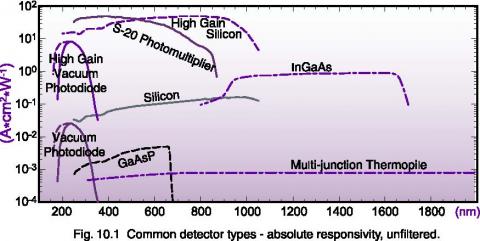
Silicon Photodiodes
Planar diffusion type silicon photodiodes are perhaps the most versatile and reliable sensors available. The P-layer material at the light sensitive surface and the N material at the substrate form a P-N junction which operates as a photoelectric converter, generating a current that is proportional to the incident light. Silicon cells operate linearly over a ten decade dynamic range, and remain true to their original calibration longer than any other type of sensor. For this reason, they are used as transfer standards at NIST.
Silicon photodiodes are best used in the short-circuit mode, with zero input impedance into an op-amp. The sensitivity of a light-sensitive circuit is limited by dark current, shot noise, and Johnson (thermal) noise. The practical limit of sensitivity occurs for an irradiance that produces a photocurrent equal to the dark current (Noise Equivalent Power, NEP = 1).
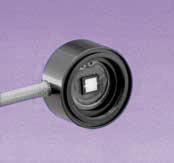
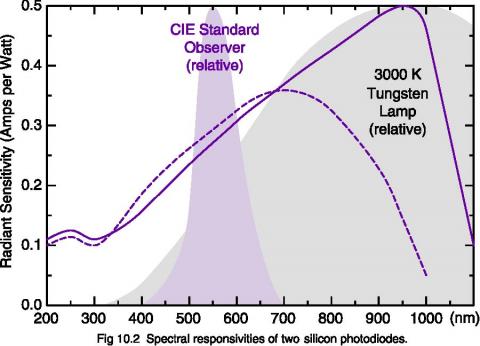
Solar-Blind Vacuum Photodiodes
The phototube is a light sensor that is based on the photoemissive effect.
The phototube is a bipolar tube which consists of a photoemissive cathode surface that emits electrons in proportion to incident light, and an anode which collects the emitted electrons. The anode must be biased at a high voltage (50 to 90 V) in order to attract electrons to jump through the vacuum of the tube. Some phototubes use a forward bias of less than 15 volts, however.
The cathode material determines the spectral sensitivity of the tube. Solar-blind vacuum photodiodes use Cs-Te cathodes to provide sensitivity only to ultraviolet light, providing as much as a million to one long wavelength rejection. A UV glass window is required for sensitivity in the UV down to 185 nm, with fused silica windows offering transmission down to 160 nm.
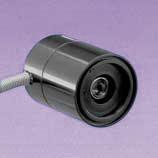
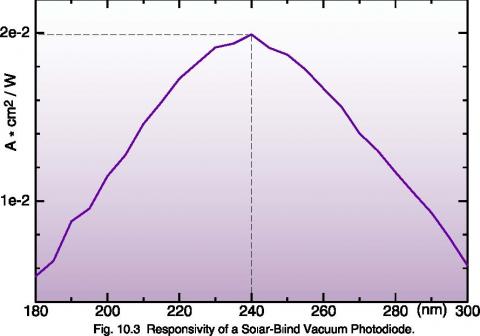
Multi-Junction Thermopiles
The thermopile is a heat sensitive device that measures radiated heat.
The sensor is usually sealed in a vacuum to prevent heat transfer except by radiation. A thermopile consists of a number of thermocouple junctions in series which convert energy into a voltage using the Peltier effect. Thermopiles are convenient sensor for measuring the infrared, because they offer adequate sensitivity and a flat spectral response in a small package. More sophisticated bolometers and pyroelectric detectors need to be chopped and are generally used only in calibration labs.
Thermopiles suffer from temperature drift, since the reference portion of the detector is constantly absorbing heat. The best method of operating a thermal detector is by chopping incident radiation, so that drift is zeroed out by the modulated reading.
The quartz window in most thermopiles is adequate for transmitting from 200 to 4200 nm, but for long wavelength sensitivity out to 40 microns, Potassium Bromide windows are used.

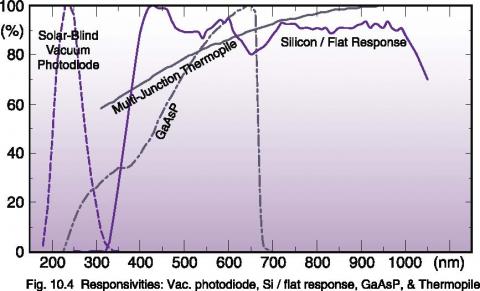

Request Light Management Handbook as PDF (ALL Chapters)
Chapter 10 - The Light Measurement Handbook
Copyright © 1997 by Alexander D. Ryer
All Rights Reserved.
No part of this publication may be reproduced or transmitted in any form or by any means, electronic or mechanical, including photocopying, recording, or any information storage and retrieval system, without permission in writing from the copyright owner. Requests should be made through the publisher.
Technical Publications Dept.
International Light Technologies
10 Technology Drive
Peabody, MA 01960
ISBN 0-9658356-9-3
Library of Congress Catalog Card Number: 97-93677
Explore more light measurement resources
- Light Meters, Lux Meters & Radiometers
- UVC Light Meters
- UV & UVC LEDs
- Light Meter Calibration
- Spectrometers & Spectroradiometers
- Light Measurement Detectors
